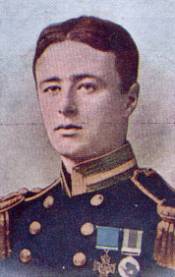
Eric Robinson was awarded the Victoria Cross for his actions of the 26th February 1915. Robinson was one of a demolition party from HMS Vengeance set ashore at Kum Kale, Gallipoli. A party accompanied by Royal Marines landed at around 2 pm, under Maj Granville Heriot DSO. The objective was to destroy any Ottoman guns that remained in working order in Kum Kale and Orkanieh. The mission was known to be difficult.
From their landing point, the demolition team was to make its way up the banks of the Mendere River. To one side they had a cemetery, ahead Achilles Mound. Beyond the mount were two batteries that had been subjected to naval bombardment: Orkanieh battery and Yeni Shehr.
The Royal Marines were to provide cover for the demolition team. This resulted in a covering position being formed in a hollow below the River. The Marines were fired upon from their left flank, then by snipers in various locations and finally with heavier fire from Yeni Shehr.
The demolition party advance continued though. HMS Dublin was asked to fire a salvo at Yeni Shehr. An officer from HMS Vengeance later described what he had seen of the early stage of the engagement:
“We saw them go past the cemetery, up to the semi-circular hollow, and they then signalled that they were attacked: so Dublin fired a salvo at the Yeni Shehr [wind] mills, which downed three mills and stopped the enemy’s fire from there. We also gave Yeni Shehr a few rounds: however, the Marines still remained in the hollow firing fairly hard. It appears they were attacked from the Mendere on their left flank, and from hidden snipers in the cemetery; also, till the guns stopped them, by a large force from Yeni Shehr…”
Under fire and with support from the straights now too dangerous to be called upon, the party was pinned down. Except, that is, Eric Robinson:
“When half way up the slope (under fire all the time from Yeni Shehr) Robinson’s party stopped and took cover, with the exception of one who went forward up to Achilles Mound, where the Vengeance’s shells had earlier dislodged two Turkish anti-aircraft guns nearby, got inside the crater at the top, walked calmly down again and, when he was just clear, we saw an explosion and up went both the anti-aircraft guns.”
Capt. Bertram Smith, commander of HMS Vengeance, explains the chaotic scenes as they were seen from the ship:
“We had been watching Eric Robinson…strolling around by himself …under heavy rifle fire from the neighbouring rise, like a sparrow enjoying a bath from a garden hose, until Dublin turned the hose off with some nicely placed salvoes. He and his party and escort were returning to the boats, while the Admiral and I were happily arranging our recommend for his V.C. when a fresh turmoil started all around them.
They had now passed out of sight in the trees of Kum Kale cemetery and none of us could see what was happening.
At length, they got a signal through to say that they were held up with the main body of the enemy in a large domed tomb. The control could see the tomb and I could just distinguish its top when they put me on. It was invisible at the guns, but I was able to note its whereabouts in the treetops, and went down to let off a 6-inch lyddite. The range was short and the range-finder laid it exactly, so the first shot sent the tomb and fragments of its inmates, both ancient and modern, flying heavenwards. Using the burst as a starting point there was no difficulty in taking the guns on to any other target to get our people clear.”
Eric Robinson did receive the Victoria Cross for these actions. One man, Sgt. Ernest Turnbull of the Royal Marines was killed during this mission and 3 were wounded.
Robinson’s V.C. citation in the London Gazette (16th August 1915):
“Lieut Commander Robinson on 26th February advanced alone, under heavy fire, into an enemy’s gun position, which might well have been occupied, and, destroying a four-inch gun, returned to his party for another charge with which the second gun was destroyed. Lieut Commander Robinson would not allow members of his demolition party to accompany him, as their white uniforms rendered them very conspicuous.”
In the period between the actions and the citation appearing in the Gazette, Robinson had gone on to achieve further notoriety for his bravery.
On 14/15th March, he commanded an unarmoured commandeered trawler through the straights on a minesweeping exercise. It was hit 84 times. On the night of 18/19th April, he then led a party to destroy an abandoned E15. He did this without cover and under heavy fire from 400-500 yards away. His immediate superiors recommended he be awarded a second Victoria Cross, this was denied though, a promotion was given instead. During the landings at Sulva on 7th August Robinson was wounded by enemy fire.
Upon recovering from his wounds he took up a command off the coast of Palestine, was again noted for his bravery: Mentioned in Despatches. By the end of the war, he had received the Order of the Nile before being transferred to the Caspian Sea. Here, he was the commander who took possession of Fort Alexandrovsk from the Bolsheviks, receiving the Russian Order of St. Anne for this. Following the end of British involvement in the Russian Civil, War Robinson was awarded the OBE. He served until retiring at the rank of Rear Admiral in 1933. The Second World War saw Robinson being recalled as a convoy commodore until ill health led to his second retirement in 1941.
Leave a Reply
You must be logged in to post a comment.